Human Resource Management Report: HRM Practices at Canary Wharf
VerifiedAdded on 2020/02/03
|20
|4550
|116
Report
AI Summary
This report provides a comprehensive analysis of Human Resource Management (HRM) practices within a firm located in Canary Wharf. It begins with an introduction that highlights the importance of HRM in maximizing employee performance and achieving organizational goals, focusing on recruitment, management, and direction of employees. The report then delves into the purpose and functions of HRM, specifically in workforce planning, examining both hard and soft approaches to HRM, and identifying key functions like recruitment, safety, employee relations, compensation, and training. The report also evaluates the strengths and weaknesses of recruitment and selection approaches, including job descriptions, skills inventories, and interview methods. Task 2 explores the benefits of HRM practices for both employers and employees, emphasizing learning and development, workforce design, employee benefits, and flexible organization. Furthermore, it evaluates the effectiveness of HRM practices through statistical data. Task 3 focuses on the importance of employee relations in HRM decision-making and analyzes key elements of employment legislation and its impact on HRM. The report concludes with a summary of the applications of HRM practices in relation to work and draws overall conclusions on the effectiveness of HRM. The report is well-researched and provides a practical overview of HRM in a real-world setting.
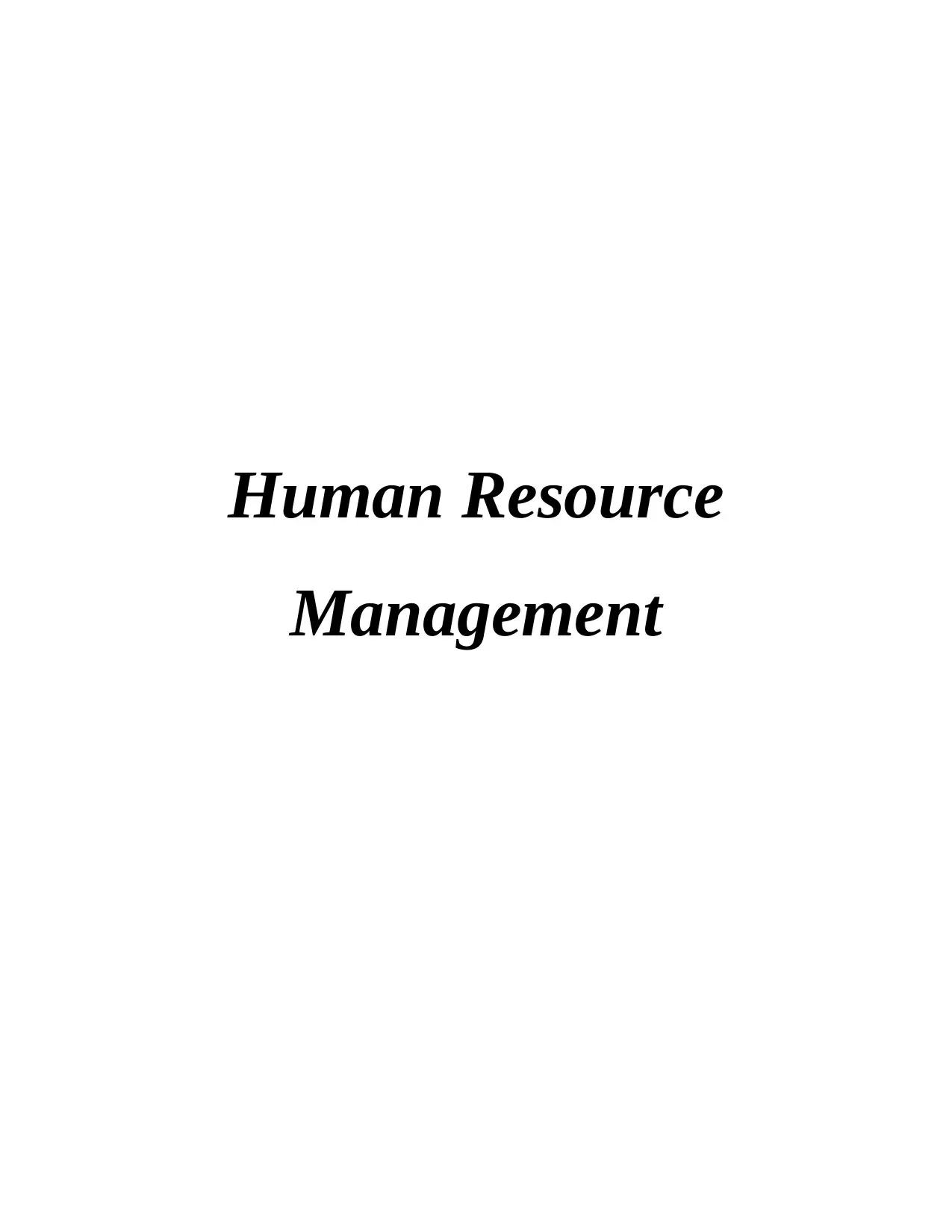
Human Resource
Management
Management
Paraphrase This Document
Need a fresh take? Get an instant paraphrase of this document with our AI Paraphraser
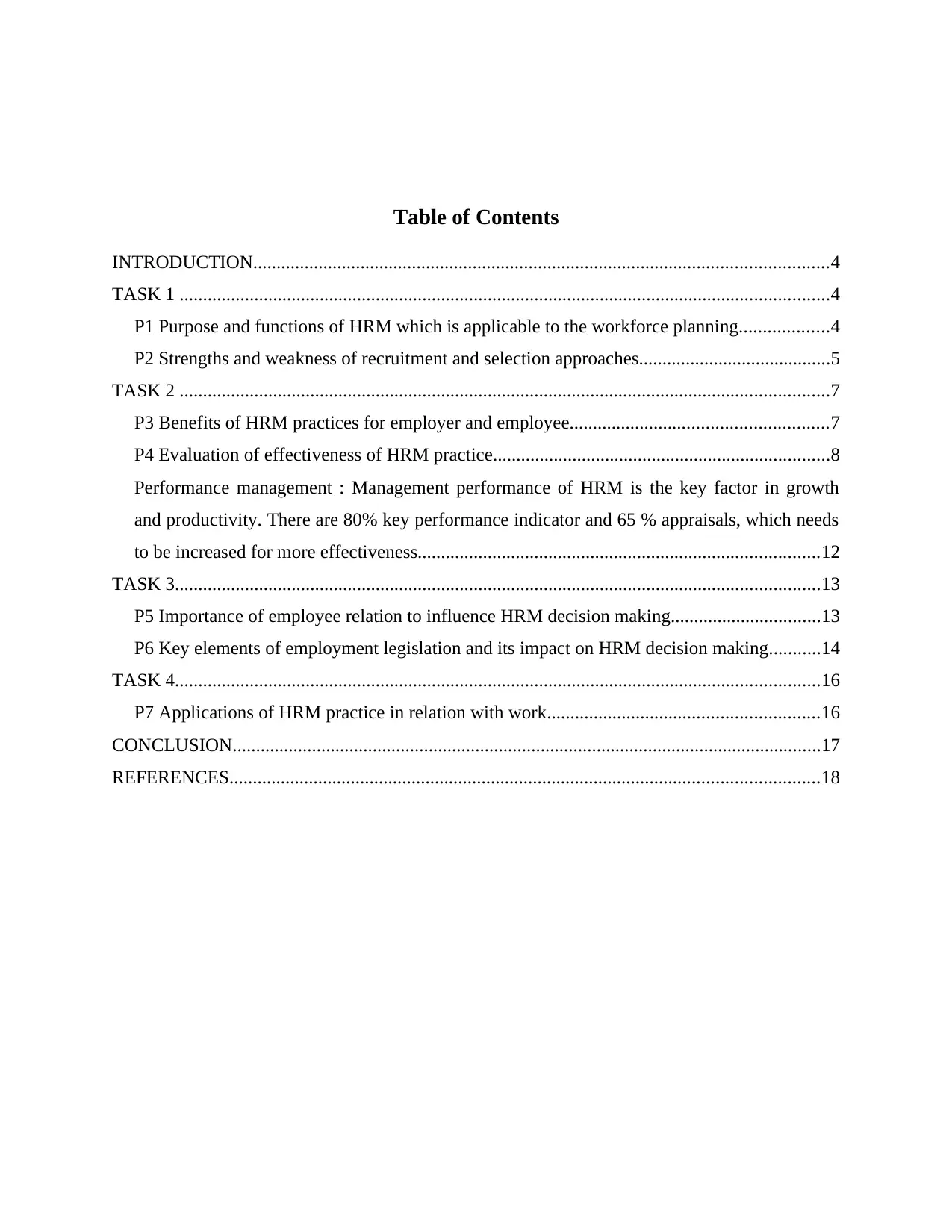
Table of Contents
INTRODUCTION...........................................................................................................................4
TASK 1 ...........................................................................................................................................4
P1 Purpose and functions of HRM which is applicable to the workforce planning...................4
P2 Strengths and weakness of recruitment and selection approaches.........................................5
TASK 2 ...........................................................................................................................................7
P3 Benefits of HRM practices for employer and employee.......................................................7
P4 Evaluation of effectiveness of HRM practice........................................................................8
Performance management : Management performance of HRM is the key factor in growth
and productivity. There are 80% key performance indicator and 65 % appraisals, which needs
to be increased for more effectiveness......................................................................................12
TASK 3..........................................................................................................................................13
P5 Importance of employee relation to influence HRM decision making................................13
P6 Key elements of employment legislation and its impact on HRM decision making...........14
TASK 4..........................................................................................................................................16
P7 Applications of HRM practice in relation with work..........................................................16
CONCLUSION..............................................................................................................................17
REFERENCES..............................................................................................................................18
INTRODUCTION...........................................................................................................................4
TASK 1 ...........................................................................................................................................4
P1 Purpose and functions of HRM which is applicable to the workforce planning...................4
P2 Strengths and weakness of recruitment and selection approaches.........................................5
TASK 2 ...........................................................................................................................................7
P3 Benefits of HRM practices for employer and employee.......................................................7
P4 Evaluation of effectiveness of HRM practice........................................................................8
Performance management : Management performance of HRM is the key factor in growth
and productivity. There are 80% key performance indicator and 65 % appraisals, which needs
to be increased for more effectiveness......................................................................................12
TASK 3..........................................................................................................................................13
P5 Importance of employee relation to influence HRM decision making................................13
P6 Key elements of employment legislation and its impact on HRM decision making...........14
TASK 4..........................................................................................................................................16
P7 Applications of HRM practice in relation with work..........................................................16
CONCLUSION..............................................................................................................................17
REFERENCES..............................................................................................................................18
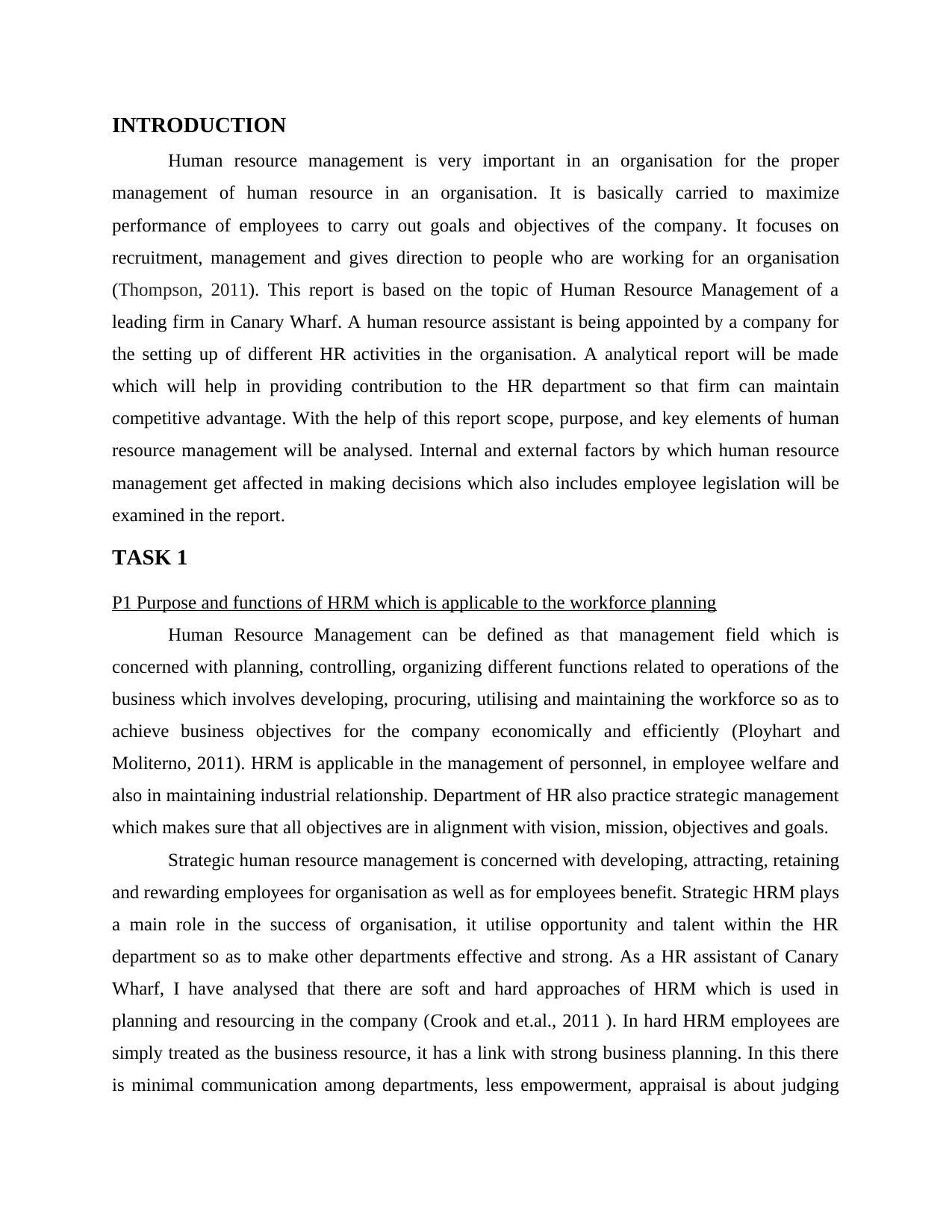
INTRODUCTION
Human resource management is very important in an organisation for the proper
management of human resource in an organisation. It is basically carried to maximize
performance of employees to carry out goals and objectives of the company. It focuses on
recruitment, management and gives direction to people who are working for an organisation
(Thompson, 2011). This report is based on the topic of Human Resource Management of a
leading firm in Canary Wharf. A human resource assistant is being appointed by a company for
the setting up of different HR activities in the organisation. A analytical report will be made
which will help in providing contribution to the HR department so that firm can maintain
competitive advantage. With the help of this report scope, purpose, and key elements of human
resource management will be analysed. Internal and external factors by which human resource
management get affected in making decisions which also includes employee legislation will be
examined in the report.
TASK 1
P1 Purpose and functions of HRM which is applicable to the workforce planning
Human Resource Management can be defined as that management field which is
concerned with planning, controlling, organizing different functions related to operations of the
business which involves developing, procuring, utilising and maintaining the workforce so as to
achieve business objectives for the company economically and efficiently (Ployhart and
Moliterno, 2011). HRM is applicable in the management of personnel, in employee welfare and
also in maintaining industrial relationship. Department of HR also practice strategic management
which makes sure that all objectives are in alignment with vision, mission, objectives and goals.
Strategic human resource management is concerned with developing, attracting, retaining
and rewarding employees for organisation as well as for employees benefit. Strategic HRM plays
a main role in the success of organisation, it utilise opportunity and talent within the HR
department so as to make other departments effective and strong. As a HR assistant of Canary
Wharf, I have analysed that there are soft and hard approaches of HRM which is used in
planning and resourcing in the company (Crook and et.al., 2011 ). In hard HRM employees are
simply treated as the business resource, it has a link with strong business planning. In this there
is minimal communication among departments, less empowerment, appraisal is about judging
Human resource management is very important in an organisation for the proper
management of human resource in an organisation. It is basically carried to maximize
performance of employees to carry out goals and objectives of the company. It focuses on
recruitment, management and gives direction to people who are working for an organisation
(Thompson, 2011). This report is based on the topic of Human Resource Management of a
leading firm in Canary Wharf. A human resource assistant is being appointed by a company for
the setting up of different HR activities in the organisation. A analytical report will be made
which will help in providing contribution to the HR department so that firm can maintain
competitive advantage. With the help of this report scope, purpose, and key elements of human
resource management will be analysed. Internal and external factors by which human resource
management get affected in making decisions which also includes employee legislation will be
examined in the report.
TASK 1
P1 Purpose and functions of HRM which is applicable to the workforce planning
Human Resource Management can be defined as that management field which is
concerned with planning, controlling, organizing different functions related to operations of the
business which involves developing, procuring, utilising and maintaining the workforce so as to
achieve business objectives for the company economically and efficiently (Ployhart and
Moliterno, 2011). HRM is applicable in the management of personnel, in employee welfare and
also in maintaining industrial relationship. Department of HR also practice strategic management
which makes sure that all objectives are in alignment with vision, mission, objectives and goals.
Strategic human resource management is concerned with developing, attracting, retaining
and rewarding employees for organisation as well as for employees benefit. Strategic HRM plays
a main role in the success of organisation, it utilise opportunity and talent within the HR
department so as to make other departments effective and strong. As a HR assistant of Canary
Wharf, I have analysed that there are soft and hard approaches of HRM which is used in
planning and resourcing in the company (Crook and et.al., 2011 ). In hard HRM employees are
simply treated as the business resource, it has a link with strong business planning. In this there
is minimal communication among departments, less empowerment, appraisal is about judging
⊘ This is a preview!⊘
Do you want full access?
Subscribe today to unlock all pages.

Trusted by 1+ million students worldwide
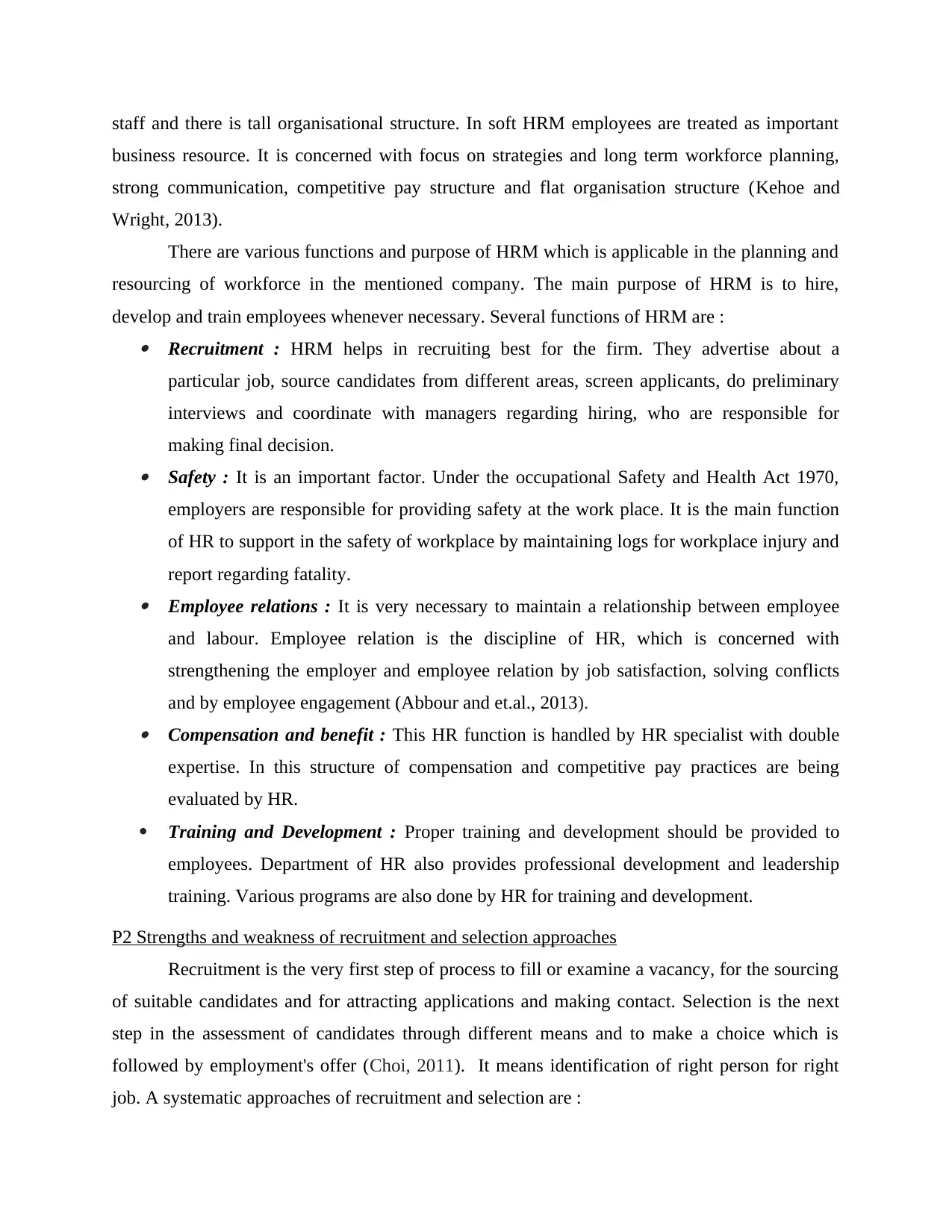
staff and there is tall organisational structure. In soft HRM employees are treated as important
business resource. It is concerned with focus on strategies and long term workforce planning,
strong communication, competitive pay structure and flat organisation structure (Kehoe and
Wright, 2013).
There are various functions and purpose of HRM which is applicable in the planning and
resourcing of workforce in the mentioned company. The main purpose of HRM is to hire,
develop and train employees whenever necessary. Several functions of HRM are : Recruitment : HRM helps in recruiting best for the firm. They advertise about a
particular job, source candidates from different areas, screen applicants, do preliminary
interviews and coordinate with managers regarding hiring, who are responsible for
making final decision. Safety : It is an important factor. Under the occupational Safety and Health Act 1970,
employers are responsible for providing safety at the work place. It is the main function
of HR to support in the safety of workplace by maintaining logs for workplace injury and
report regarding fatality. Employee relations : It is very necessary to maintain a relationship between employee
and labour. Employee relation is the discipline of HR, which is concerned with
strengthening the employer and employee relation by job satisfaction, solving conflicts
and by employee engagement (Abbour and et.al., 2013). Compensation and benefit : This HR function is handled by HR specialist with double
expertise. In this structure of compensation and competitive pay practices are being
evaluated by HR.
Training and Development : Proper training and development should be provided to
employees. Department of HR also provides professional development and leadership
training. Various programs are also done by HR for training and development.
P2 Strengths and weakness of recruitment and selection approaches
Recruitment is the very first step of process to fill or examine a vacancy, for the sourcing
of suitable candidates and for attracting applications and making contact. Selection is the next
step in the assessment of candidates through different means and to make a choice which is
followed by employment's offer (Choi, 2011). It means identification of right person for right
job. A systematic approaches of recruitment and selection are :
business resource. It is concerned with focus on strategies and long term workforce planning,
strong communication, competitive pay structure and flat organisation structure (Kehoe and
Wright, 2013).
There are various functions and purpose of HRM which is applicable in the planning and
resourcing of workforce in the mentioned company. The main purpose of HRM is to hire,
develop and train employees whenever necessary. Several functions of HRM are : Recruitment : HRM helps in recruiting best for the firm. They advertise about a
particular job, source candidates from different areas, screen applicants, do preliminary
interviews and coordinate with managers regarding hiring, who are responsible for
making final decision. Safety : It is an important factor. Under the occupational Safety and Health Act 1970,
employers are responsible for providing safety at the work place. It is the main function
of HR to support in the safety of workplace by maintaining logs for workplace injury and
report regarding fatality. Employee relations : It is very necessary to maintain a relationship between employee
and labour. Employee relation is the discipline of HR, which is concerned with
strengthening the employer and employee relation by job satisfaction, solving conflicts
and by employee engagement (Abbour and et.al., 2013). Compensation and benefit : This HR function is handled by HR specialist with double
expertise. In this structure of compensation and competitive pay practices are being
evaluated by HR.
Training and Development : Proper training and development should be provided to
employees. Department of HR also provides professional development and leadership
training. Various programs are also done by HR for training and development.
P2 Strengths and weakness of recruitment and selection approaches
Recruitment is the very first step of process to fill or examine a vacancy, for the sourcing
of suitable candidates and for attracting applications and making contact. Selection is the next
step in the assessment of candidates through different means and to make a choice which is
followed by employment's offer (Choi, 2011). It means identification of right person for right
job. A systematic approaches of recruitment and selection are :
Paraphrase This Document
Need a fresh take? Get an instant paraphrase of this document with our AI Paraphraser
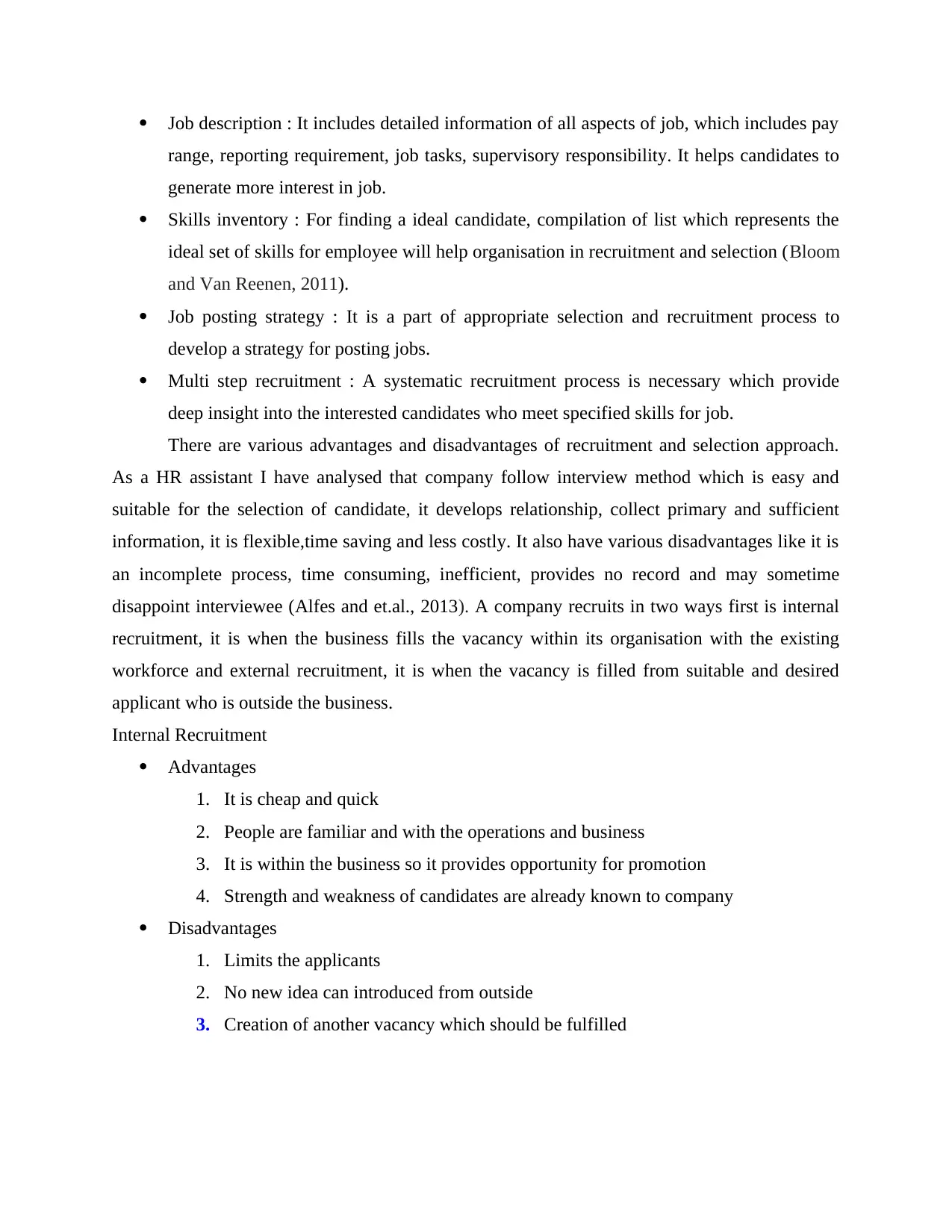
Job description : It includes detailed information of all aspects of job, which includes pay
range, reporting requirement, job tasks, supervisory responsibility. It helps candidates to
generate more interest in job.
Skills inventory : For finding a ideal candidate, compilation of list which represents the
ideal set of skills for employee will help organisation in recruitment and selection (Bloom
and Van Reenen, 2011).
Job posting strategy : It is a part of appropriate selection and recruitment process to
develop a strategy for posting jobs.
Multi step recruitment : A systematic recruitment process is necessary which provide
deep insight into the interested candidates who meet specified skills for job.
There are various advantages and disadvantages of recruitment and selection approach.
As a HR assistant I have analysed that company follow interview method which is easy and
suitable for the selection of candidate, it develops relationship, collect primary and sufficient
information, it is flexible,time saving and less costly. It also have various disadvantages like it is
an incomplete process, time consuming, inefficient, provides no record and may sometime
disappoint interviewee (Alfes and et.al., 2013). A company recruits in two ways first is internal
recruitment, it is when the business fills the vacancy within its organisation with the existing
workforce and external recruitment, it is when the vacancy is filled from suitable and desired
applicant who is outside the business.
Internal Recruitment
Advantages
1. It is cheap and quick
2. People are familiar and with the operations and business
3. It is within the business so it provides opportunity for promotion
4. Strength and weakness of candidates are already known to company
Disadvantages
1. Limits the applicants
2. No new idea can introduced from outside
3. Creation of another vacancy which should be fulfilled
range, reporting requirement, job tasks, supervisory responsibility. It helps candidates to
generate more interest in job.
Skills inventory : For finding a ideal candidate, compilation of list which represents the
ideal set of skills for employee will help organisation in recruitment and selection (Bloom
and Van Reenen, 2011).
Job posting strategy : It is a part of appropriate selection and recruitment process to
develop a strategy for posting jobs.
Multi step recruitment : A systematic recruitment process is necessary which provide
deep insight into the interested candidates who meet specified skills for job.
There are various advantages and disadvantages of recruitment and selection approach.
As a HR assistant I have analysed that company follow interview method which is easy and
suitable for the selection of candidate, it develops relationship, collect primary and sufficient
information, it is flexible,time saving and less costly. It also have various disadvantages like it is
an incomplete process, time consuming, inefficient, provides no record and may sometime
disappoint interviewee (Alfes and et.al., 2013). A company recruits in two ways first is internal
recruitment, it is when the business fills the vacancy within its organisation with the existing
workforce and external recruitment, it is when the vacancy is filled from suitable and desired
applicant who is outside the business.
Internal Recruitment
Advantages
1. It is cheap and quick
2. People are familiar and with the operations and business
3. It is within the business so it provides opportunity for promotion
4. Strength and weakness of candidates are already known to company
Disadvantages
1. Limits the applicants
2. No new idea can introduced from outside
3. Creation of another vacancy which should be fulfilled
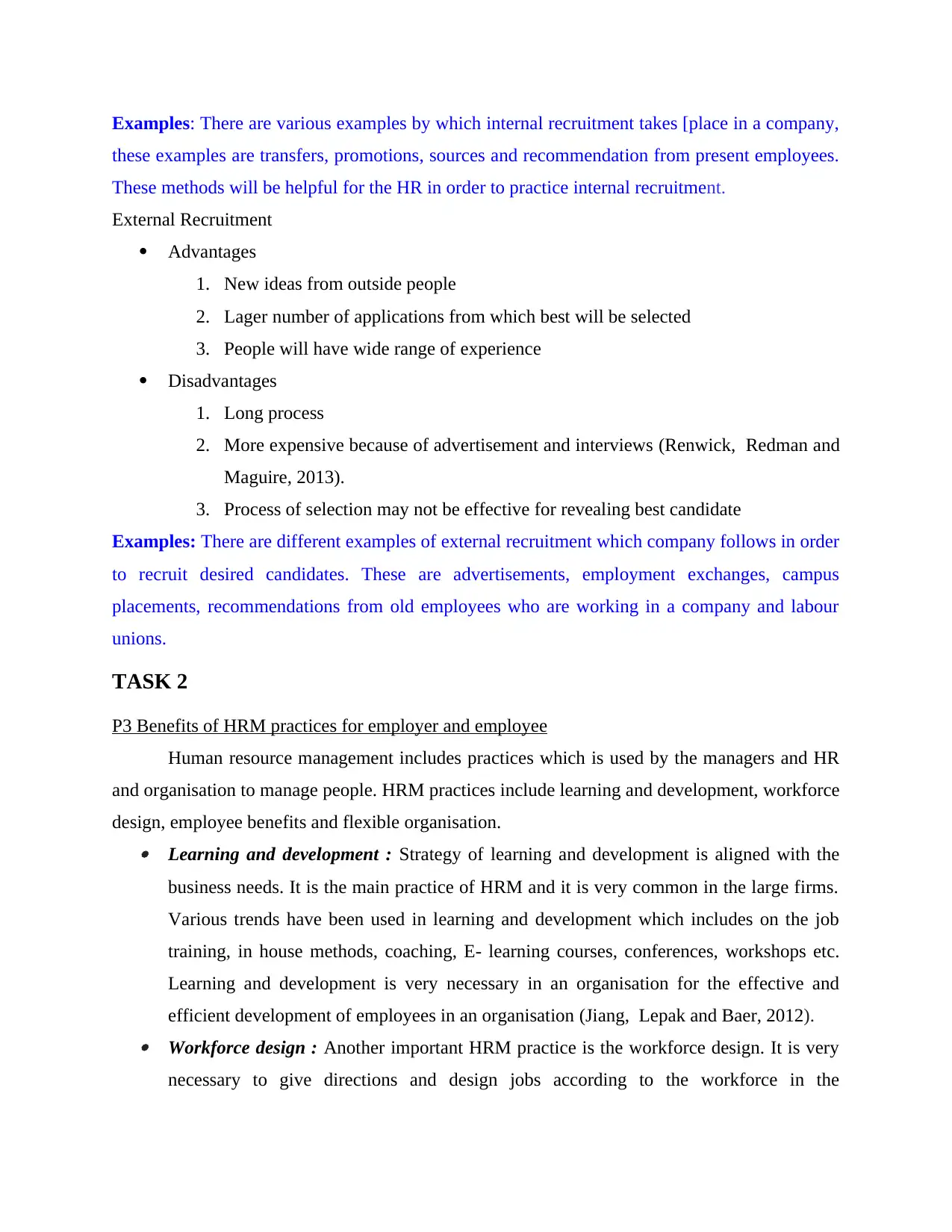
Examples: There are various examples by which internal recruitment takes [place in a company,
these examples are transfers, promotions, sources and recommendation from present employees.
These methods will be helpful for the HR in order to practice internal recruitment.
External Recruitment
Advantages
1. New ideas from outside people
2. Lager number of applications from which best will be selected
3. People will have wide range of experience
Disadvantages
1. Long process
2. More expensive because of advertisement and interviews (Renwick, Redman and
Maguire, 2013).
3. Process of selection may not be effective for revealing best candidate
Examples: There are different examples of external recruitment which company follows in order
to recruit desired candidates. These are advertisements, employment exchanges, campus
placements, recommendations from old employees who are working in a company and labour
unions.
TASK 2
P3 Benefits of HRM practices for employer and employee
Human resource management includes practices which is used by the managers and HR
and organisation to manage people. HRM practices include learning and development, workforce
design, employee benefits and flexible organisation. Learning and development : Strategy of learning and development is aligned with the
business needs. It is the main practice of HRM and it is very common in the large firms.
Various trends have been used in learning and development which includes on the job
training, in house methods, coaching, E- learning courses, conferences, workshops etc.
Learning and development is very necessary in an organisation for the effective and
efficient development of employees in an organisation (Jiang, Lepak and Baer, 2012). Workforce design : Another important HRM practice is the workforce design. It is very
necessary to give directions and design jobs according to the workforce in the
these examples are transfers, promotions, sources and recommendation from present employees.
These methods will be helpful for the HR in order to practice internal recruitment.
External Recruitment
Advantages
1. New ideas from outside people
2. Lager number of applications from which best will be selected
3. People will have wide range of experience
Disadvantages
1. Long process
2. More expensive because of advertisement and interviews (Renwick, Redman and
Maguire, 2013).
3. Process of selection may not be effective for revealing best candidate
Examples: There are different examples of external recruitment which company follows in order
to recruit desired candidates. These are advertisements, employment exchanges, campus
placements, recommendations from old employees who are working in a company and labour
unions.
TASK 2
P3 Benefits of HRM practices for employer and employee
Human resource management includes practices which is used by the managers and HR
and organisation to manage people. HRM practices include learning and development, workforce
design, employee benefits and flexible organisation. Learning and development : Strategy of learning and development is aligned with the
business needs. It is the main practice of HRM and it is very common in the large firms.
Various trends have been used in learning and development which includes on the job
training, in house methods, coaching, E- learning courses, conferences, workshops etc.
Learning and development is very necessary in an organisation for the effective and
efficient development of employees in an organisation (Jiang, Lepak and Baer, 2012). Workforce design : Another important HRM practice is the workforce design. It is very
necessary to give directions and design jobs according to the workforce in the
⊘ This is a preview!⊘
Do you want full access?
Subscribe today to unlock all pages.

Trusted by 1+ million students worldwide
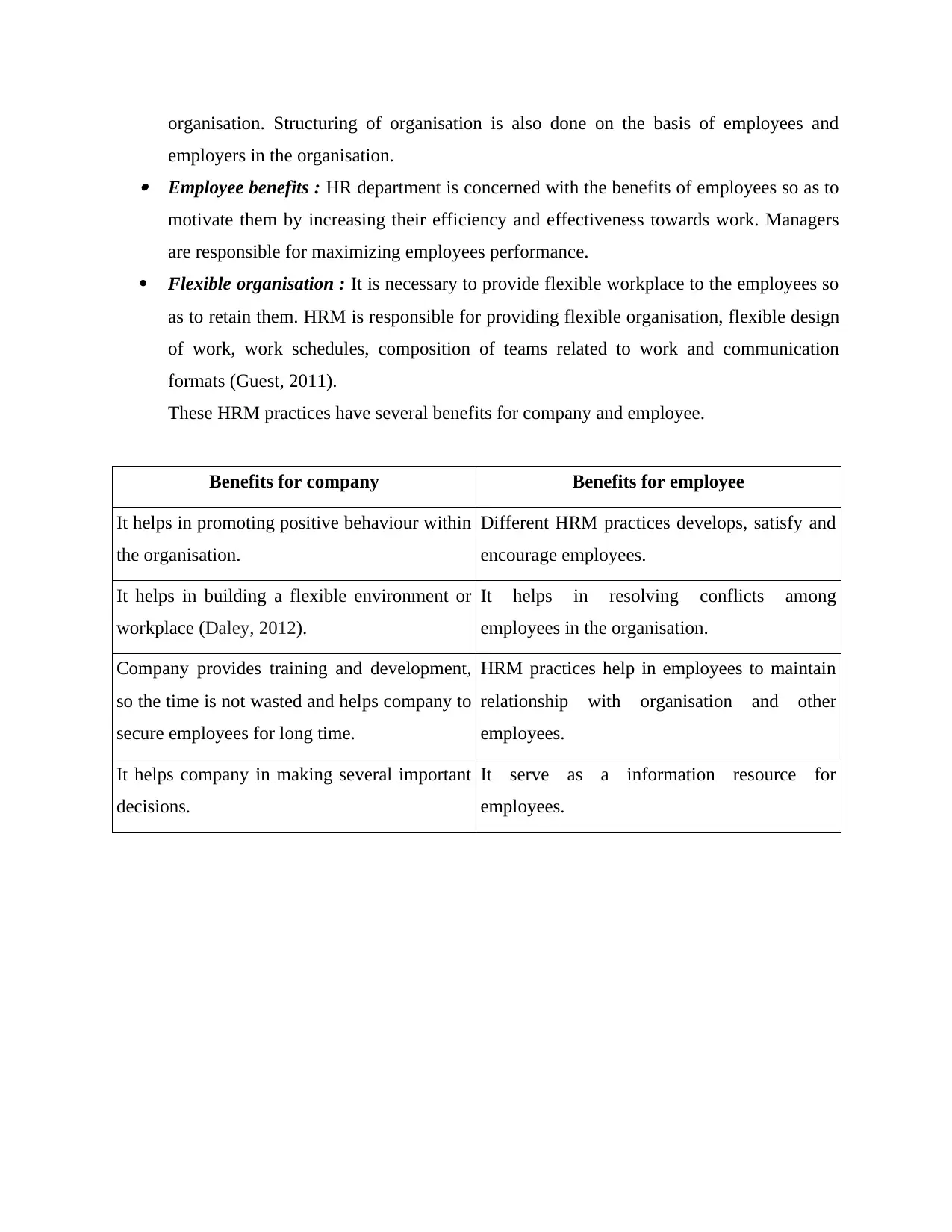
organisation. Structuring of organisation is also done on the basis of employees and
employers in the organisation. Employee benefits : HR department is concerned with the benefits of employees so as to
motivate them by increasing their efficiency and effectiveness towards work. Managers
are responsible for maximizing employees performance.
Flexible organisation : It is necessary to provide flexible workplace to the employees so
as to retain them. HRM is responsible for providing flexible organisation, flexible design
of work, work schedules, composition of teams related to work and communication
formats (Guest, 2011).
These HRM practices have several benefits for company and employee.
Benefits for company Benefits for employee
It helps in promoting positive behaviour within
the organisation.
Different HRM practices develops, satisfy and
encourage employees.
It helps in building a flexible environment or
workplace (Daley, 2012).
It helps in resolving conflicts among
employees in the organisation.
Company provides training and development,
so the time is not wasted and helps company to
secure employees for long time.
HRM practices help in employees to maintain
relationship with organisation and other
employees.
It helps company in making several important
decisions.
It serve as a information resource for
employees.
employers in the organisation. Employee benefits : HR department is concerned with the benefits of employees so as to
motivate them by increasing their efficiency and effectiveness towards work. Managers
are responsible for maximizing employees performance.
Flexible organisation : It is necessary to provide flexible workplace to the employees so
as to retain them. HRM is responsible for providing flexible organisation, flexible design
of work, work schedules, composition of teams related to work and communication
formats (Guest, 2011).
These HRM practices have several benefits for company and employee.
Benefits for company Benefits for employee
It helps in promoting positive behaviour within
the organisation.
Different HRM practices develops, satisfy and
encourage employees.
It helps in building a flexible environment or
workplace (Daley, 2012).
It helps in resolving conflicts among
employees in the organisation.
Company provides training and development,
so the time is not wasted and helps company to
secure employees for long time.
HRM practices help in employees to maintain
relationship with organisation and other
employees.
It helps company in making several important
decisions.
It serve as a information resource for
employees.
Paraphrase This Document
Need a fresh take? Get an instant paraphrase of this document with our AI Paraphraser
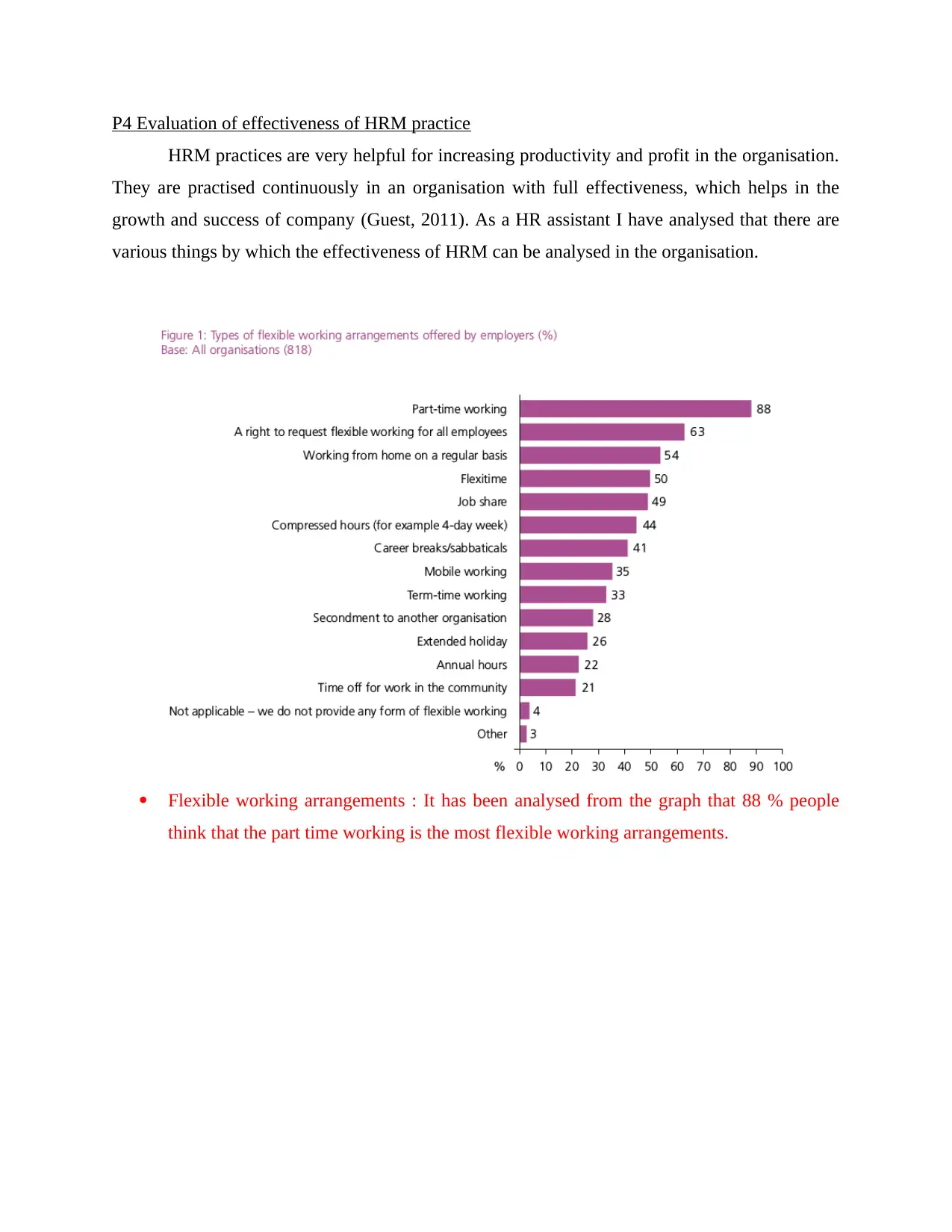
P4 Evaluation of effectiveness of HRM practice
HRM practices are very helpful for increasing productivity and profit in the organisation.
They are practised continuously in an organisation with full effectiveness, which helps in the
growth and success of company (Guest, 2011). As a HR assistant I have analysed that there are
various things by which the effectiveness of HRM can be analysed in the organisation.
Flexible working arrangements : It has been analysed from the graph that 88 % people
think that the part time working is the most flexible working arrangements.
HRM practices are very helpful for increasing productivity and profit in the organisation.
They are practised continuously in an organisation with full effectiveness, which helps in the
growth and success of company (Guest, 2011). As a HR assistant I have analysed that there are
various things by which the effectiveness of HRM can be analysed in the organisation.
Flexible working arrangements : It has been analysed from the graph that 88 % people
think that the part time working is the most flexible working arrangements.
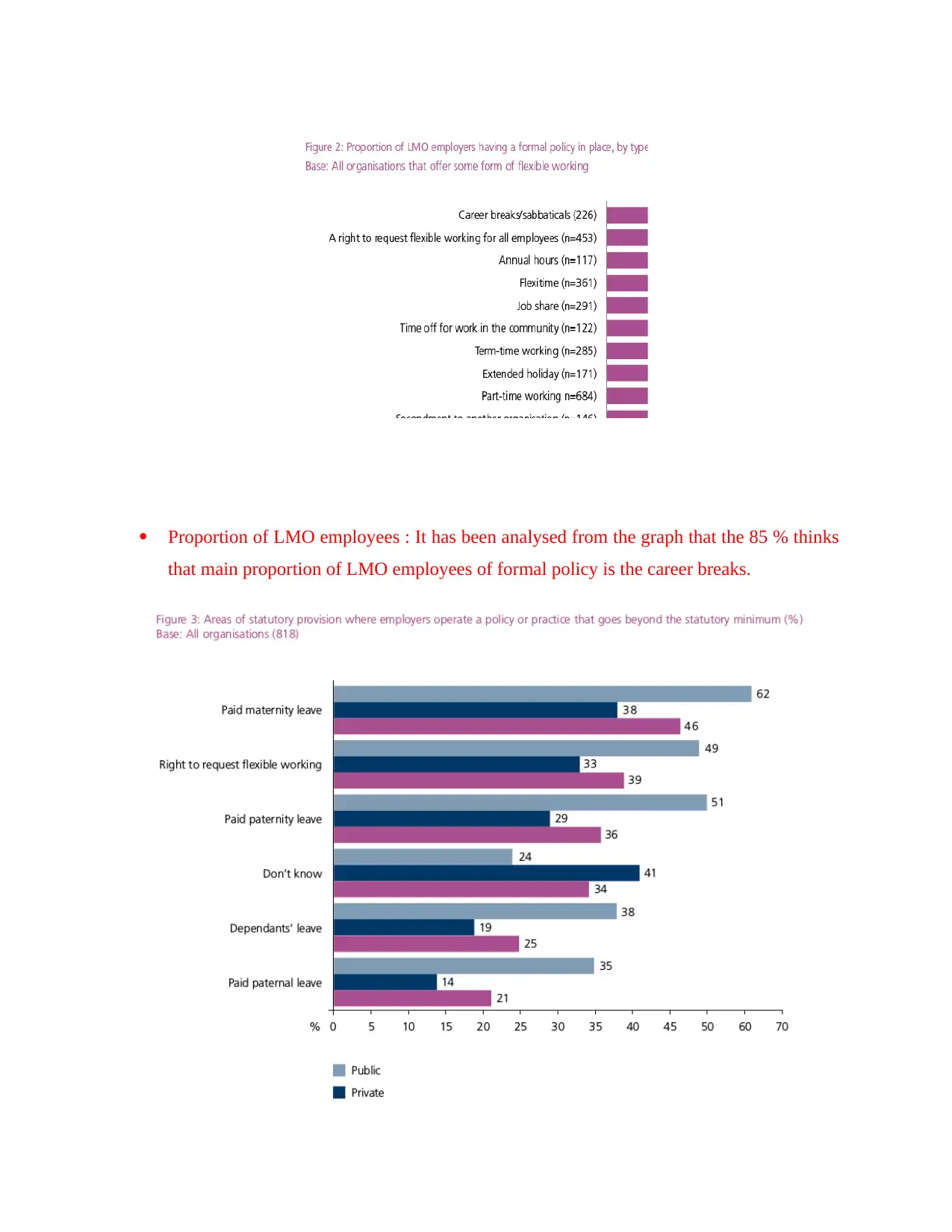
Proportion of LMO employees : It has been analysed from the graph that the 85 % thinks
that main proportion of LMO employees of formal policy is the career breaks.
that main proportion of LMO employees of formal policy is the career breaks.
⊘ This is a preview!⊘
Do you want full access?
Subscribe today to unlock all pages.

Trusted by 1+ million students worldwide
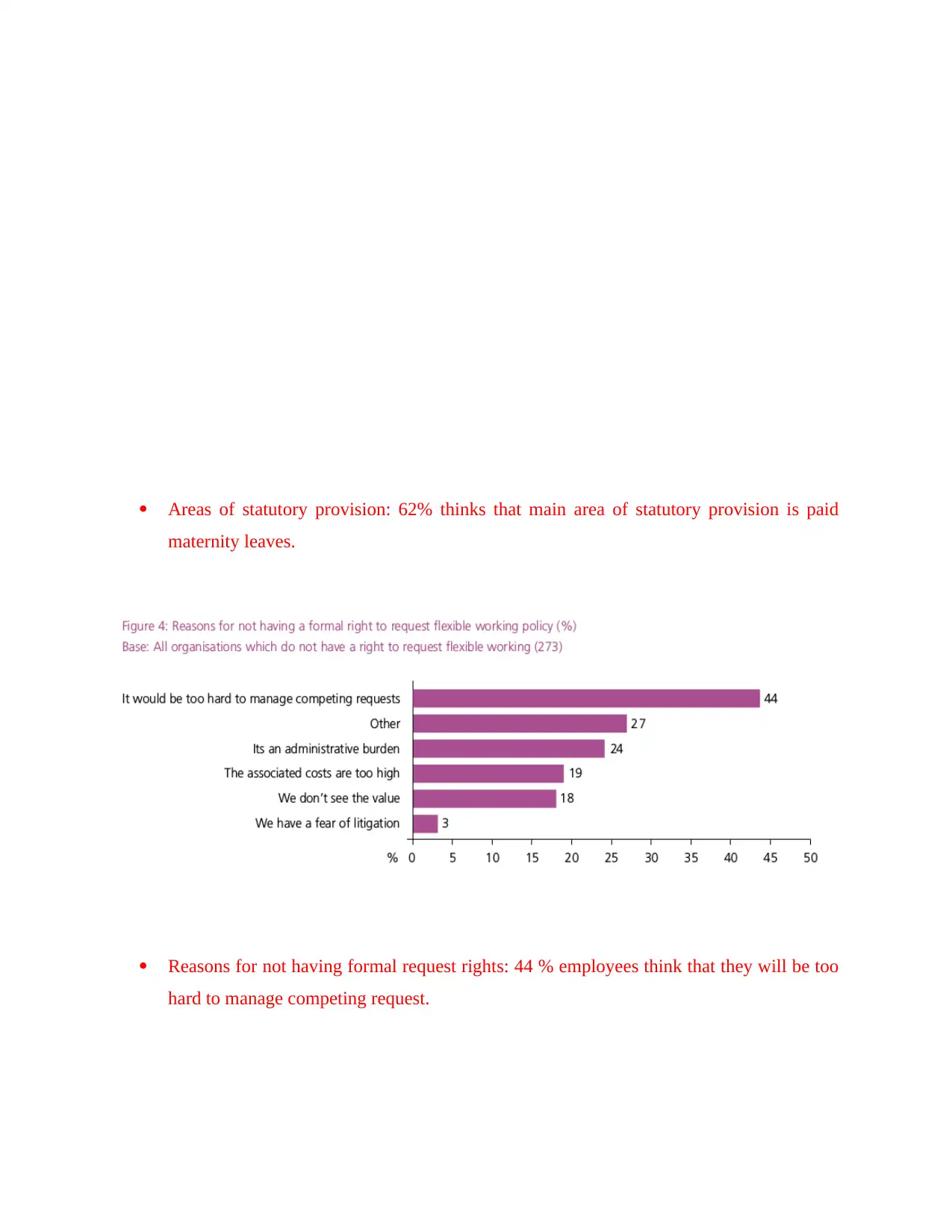
Areas of statutory provision: 62% thinks that main area of statutory provision is paid
maternity leaves.
Reasons for not having formal request rights: 44 % employees think that they will be too
hard to manage competing request.
maternity leaves.
Reasons for not having formal request rights: 44 % employees think that they will be too
hard to manage competing request.
Paraphrase This Document
Need a fresh take? Get an instant paraphrase of this document with our AI Paraphraser
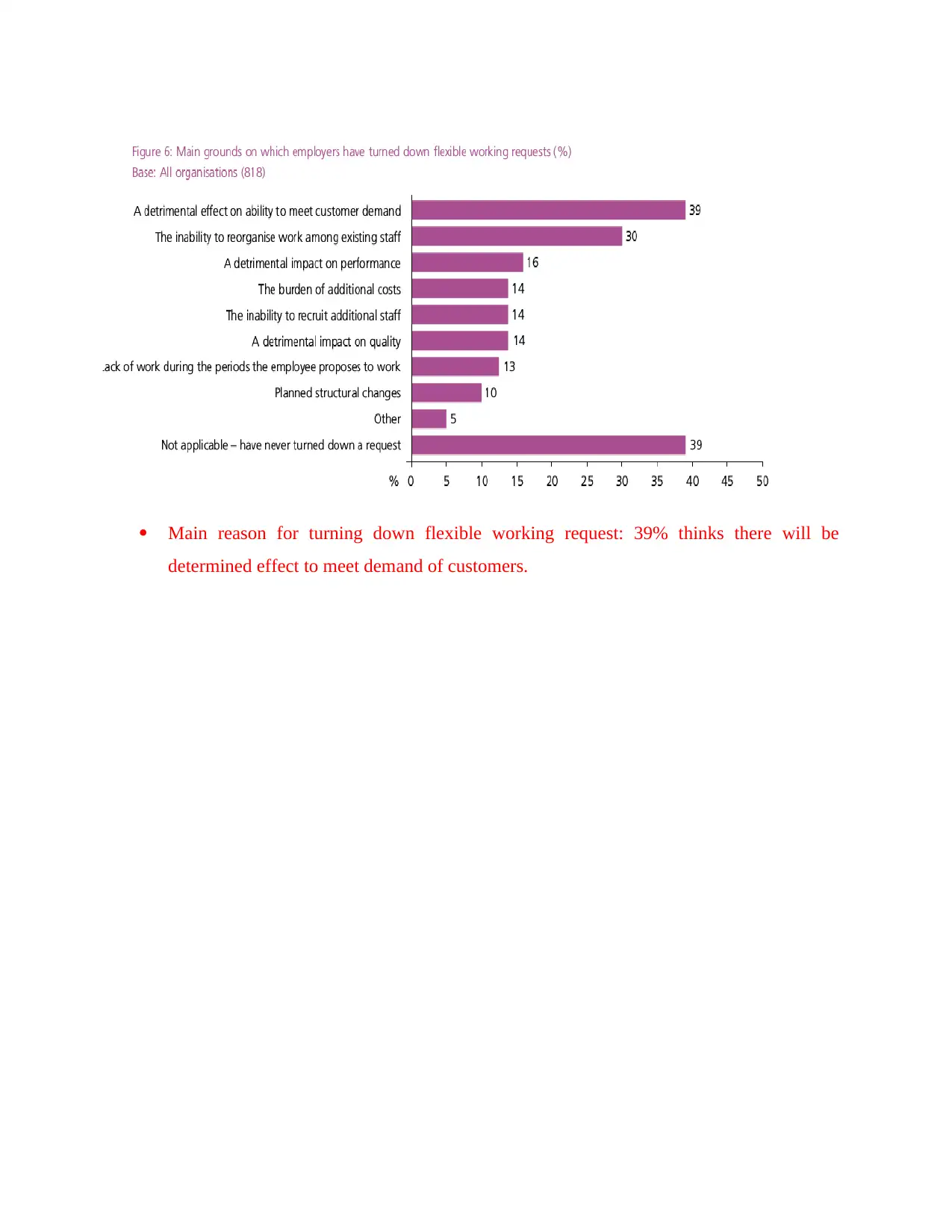
Main reason for turning down flexible working request: 39% thinks there will be
determined effect to meet demand of customers.
determined effect to meet demand of customers.
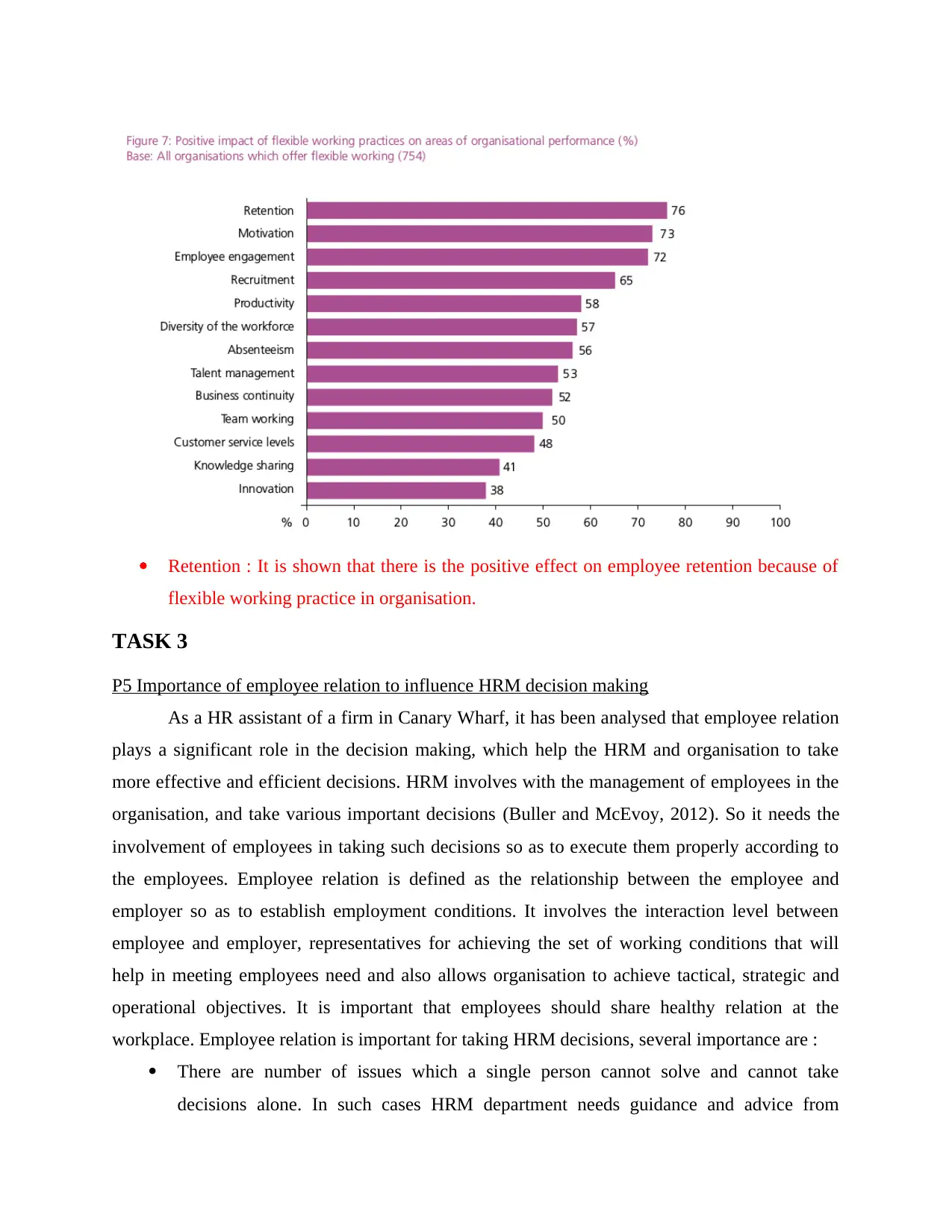
Retention : It is shown that there is the positive effect on employee retention because of
flexible working practice in organisation.
TASK 3
P5 Importance of employee relation to influence HRM decision making
As a HR assistant of a firm in Canary Wharf, it has been analysed that employee relation
plays a significant role in the decision making, which help the HRM and organisation to take
more effective and efficient decisions. HRM involves with the management of employees in the
organisation, and take various important decisions (Buller and McEvoy, 2012). So it needs the
involvement of employees in taking such decisions so as to execute them properly according to
the employees. Employee relation is defined as the relationship between the employee and
employer so as to establish employment conditions. It involves the interaction level between
employee and employer, representatives for achieving the set of working conditions that will
help in meeting employees need and also allows organisation to achieve tactical, strategic and
operational objectives. It is important that employees should share healthy relation at the
workplace. Employee relation is important for taking HRM decisions, several importance are :
There are number of issues which a single person cannot solve and cannot take
decisions alone. In such cases HRM department needs guidance and advice from
flexible working practice in organisation.
TASK 3
P5 Importance of employee relation to influence HRM decision making
As a HR assistant of a firm in Canary Wharf, it has been analysed that employee relation
plays a significant role in the decision making, which help the HRM and organisation to take
more effective and efficient decisions. HRM involves with the management of employees in the
organisation, and take various important decisions (Buller and McEvoy, 2012). So it needs the
involvement of employees in taking such decisions so as to execute them properly according to
the employees. Employee relation is defined as the relationship between the employee and
employer so as to establish employment conditions. It involves the interaction level between
employee and employer, representatives for achieving the set of working conditions that will
help in meeting employees need and also allows organisation to achieve tactical, strategic and
operational objectives. It is important that employees should share healthy relation at the
workplace. Employee relation is important for taking HRM decisions, several importance are :
There are number of issues which a single person cannot solve and cannot take
decisions alone. In such cases HRM department needs guidance and advice from
⊘ This is a preview!⊘
Do you want full access?
Subscribe today to unlock all pages.

Trusted by 1+ million students worldwide
1 out of 20
Related Documents
Your All-in-One AI-Powered Toolkit for Academic Success.
+13062052269
info@desklib.com
Available 24*7 on WhatsApp / Email
![[object Object]](/_next/static/media/star-bottom.7253800d.svg)
Unlock your academic potential
Copyright © 2020–2025 A2Z Services. All Rights Reserved. Developed and managed by ZUCOL.





